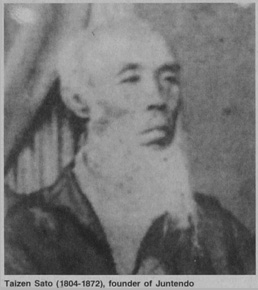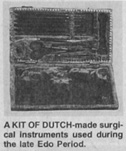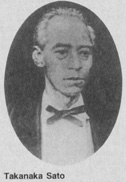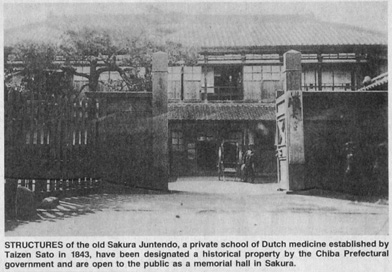About Juntendo
TOPICS -THE JAPAN TIMES (Sat,Dec 25,2004) -
A legacy of healing, education in a changing world

Taizen was born in Inage, now Kawasaki city near Tokyo, in 1804. He studied Dutch medicine in Nagasaki, then Japan's only port open to foreign trade and Western learning, for three years when he was in his late 20s.
He became a skilled surgeon and, at age 33, hung out a shingle for a medical clinic. At a time when the Tokugawa shogunate was under pressure to open the country to extensive foreign contact, he established a private medical school called "Wadajuku" in 1838.
In 1843 Taizen was invited by Masayoshi Hotta (1810-1864), the feudal lord of the Sakura domain, to serve as guest home doctor. So he moved Wadajuku from Edo to Sakura and changed the school's name to Juntendo.
Taizen successfully conducted surgical operations on people without anesthesia and administered inoculations against smallpox, beginning with his son. Their effectiveness was demonstrated during an epidemic.
Hearing of his reputation, many students came to Sakura to study medicine with Taizen. Some of the students later became leaders in the fields of not only medical science and education but also medical administration in this country.
In 1853, Taizen adopted Dokai Hayashi, one of his old friends who had also studied Dutch medicine in Nagasaki, as his son and renamed him Takanaka Sato (1827-1882). In 1859, Takanaka became the second president of Juntendo. His surgical skill was reputed to be as good as Taizen's, further increasing Juntendo's reputation.
 Taizen's own son, Ryojun Matsumoto (1832-1907), who turned out to be one of the most celebrated doctors in Japanese history, did not succeed his father as a Juntendo leader. He became Japan's first surgeon general in 1873.
Taizen's own son, Ryojun Matsumoto (1832-1907), who turned out to be one of the most celebrated doctors in Japanese history, did not succeed his father as a Juntendo leader. He became Japan's first surgeon general in 1873.
Although most of the documents concerning Juntendo's early history were destroyed in fires from the Great Kanto Earthquake of 1923 and the bombings of World War II, surviving documents showed that Taizen played an important role in medical practice as well as education. Included are books about Western medicine translated by Taizen into Japanese.
In early 1872 Taizen fell ill with pneumonia and prepared to die. Takanaka did his best to treat him, but his adopted father and mentor refused food and medicine. He died April 10 at 69. He practiced "Junten," meaning that he "followed the way of heaven and the laws of nature."
Takanaka educated students at Daigaku Toko, now the University of Tokyo School of Medicine, serving as dean at the request of the Meiji government. In 1875, Takanaka retired from this medical institution and founded Japan's first private hospital in Tokyo, named Juntendo Hospital.
Takanaka's adopted son Susumu Sato (1854-1921), who later became the third president of Juntendo, went to study medicine at the University of Berlin. He was the first student from Japan to study abroad officially. After graduating, Susumu studied under Theodor Billroth, a professor of surgery at Vienna University. In 1887 Susumu founded the Journal of Juntendo Medical Research, which contributed to the progress of medical science in Japan. This journal continues to publish medical research today.
 Specialization clinics were set up at Juntendo Hospital beginning in 1886 with internal medicine and surgery. Ophthalmology was added in 1891, plastic surgery in 1901, urology in 1903, dermatology in 1908, obstetrics and gynecology in 1910, radiology in 1912, pediatrics in 1920 and orthopedic surgery in 1934.
Specialization clinics were set up at Juntendo Hospital beginning in 1886 with internal medicine and surgery. Ophthalmology was added in 1891, plastic surgery in 1901, urology in 1903, dermatology in 1908, obstetrics and gynecology in 1910, radiology in 1912, pediatrics in 1920 and orthopedic surgery in 1934.During World War II, the fourth Juntendo president, Tatsujiro Sato (1868-1959), who was Susumu's adopted son, founded the Juntendo Foundation to promote medical education, clinical practice and sports instruction.
After World War II, Tatsujiro's son in law, Noboru Ariyama (1896-1988), formed the new Juntendo University and established the first intensive care unit in Japan. He also organized the hospital into departments by specialties and subspecialties.
Following the tenures of Takehiko Azuma (1926-1987) and Katsumi Kaketa (1906-1996), Shozo Ishii became chairman of the Juntendo board of trustees in 1992. Under their leadership, Juntendo has developed constantly to provide excellence in medical education, research and practice in Japan.
Ever since its founding, Juntendo University has aimed to verse medical students in both the scientific and humanitarian aspects of medicine. Its philosophy is based on the belief that healing the soul with a warm heart is just as important as treating the body.
In its teaching curriculum, the university places priority on patient-oriented management and the ability to adjust to changes in conditions and technology, while fostering the will and courage to challenge the unknown.
Conveniently located in the heart of Tokyo, the university draws patients from all over the country who are referred to it for advanced medical treatment. The large number of patients enables the university to accumulate massive databases in support of various medical studies.
 The university is amply funded as it leads other Japanese private medical schools in the amount of research subsidies from the Ministry of Education, Culture, Sports, Science and Technology. It also receives large amounts of research funds from private corporations as-unlike public institutions-it is not restricted in the amounts received from the private sector.
The university is amply funded as it leads other Japanese private medical schools in the amount of research subsidies from the Ministry of Education, Culture, Sports, Science and Technology. It also receives large amounts of research funds from private corporations as-unlike public institutions-it is not restricted in the amounts received from the private sector.
Juntendo people are aware of the fact that medical expenses have been increasing. The government is trying to reduce national health-care spending while striving to maintain people's welfare in general and enhance the quality of life for the elderly.
Four Juntendo hospitals, including the Juntendo University Hospital in Tokyo, are equipped with state-of-the-art medical facilities.
The university takes pride in the large number of researchers it accepts from abroad. The world of academics is without national borders, and it believes that working together with intellectuals from different backgrounds will result in the development of new ideas and discoveries.
Series of lectures to focus on Juntendo founder Sato
In commemoration of the 200th anniversary of the birth of Taizen Sato, founding father of Juntendo, Juntendo University is holding a lecture series Saturday on Taizen's foresight and his theories about medicine.The lectures will be held from 3 p.m. to 5 p.m. with novelist Akira Yoshimura and three other people delivering speeches at Juntendo University Ariyama Kinen Kodo (Ariyama Memorial Auditorium) in the Hongo section of Bunkyo Ward, Tokyo, about five minutes' walk from JR Ochanomizu Station.
Yoshimura is expected to talk about Taizen while referring to his second son Ryojun Matsumoto, about whom he recently wrote the book Akatsuki-no-tabibito ("Dawn Traveler").
Hideoki Ogawa, president of Juntendo University, will discuss Juntendo's genealogy.
Visiting professor Shizu Sakai will deliver a speech about Taizen's achievement and foresight, and professor Okio Hino will talk about the significance of "JIN" in medical science.
The lecture series will be presided over by Professor Eiki Kominami, dean of the university's School of Medicine.
Admission is free of charge.
